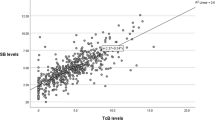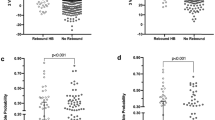Abstract
Objective:
To evaluate predischarge transcutaneous bilirubin (TcB) measurements combined with risk factors as predictors of the risk of a subsequent total serum bilirubin (TSB) ⩾17 mg per 100 ml (291 μmol l−1).
Study Design:
Routine TcB measurements are obtained daily for all infants in our well baby nursery. We performed a nested case–control study comparing all 75 infants who had been readmitted with TSB ⩾17 mg per 100 ml (291 μmol l−1) between 1 February 2005 and 28 February 2007 with randomly selected controls that had not been readmitted.
Result:
Between 1 February 2005 and 28 February 2007, 11 456 infants were discharged from the well baby nursery. Seventy-five infants (0.65%) were readmitted at a mean age of 110±29.9 h with a TSB⩾17 mg per 100 ml (291 μmol l−1). All received phototherapy. Using logistic regression analysis, three variables were statistically significant for predicting cases: the maximum predischarge TcB percentile group (P<0.0001, adjusted odds ratio (AOR), >95th percentile 148; 95% confidence interval (CI) 21 to >999, AOR 76 to 95th percentile 15; 95% CI 3.1 to 70, AOR 50 to 75th percentile 6.1; 95% CI 1.3 to 28 compared with <50th percentile), exclusive breastfeeding (P<0.0001, AOR 11; 95% CI 3.7 to 34) and gestational age (P=0.0057, AOR 35 to 36 6/7 week 21; 95% CI 2.3 to 185, AOR 37 to 37 6/7 week 15; 95% CI 1.9 to 115, AOR 38 to 38 6/7 week 1.8; 95% CI 0.3 to 11, AOR 39 to 39 6/7 week 1.1; 95% CI 0.2 to 7 AOR ⩾41 week 0.88; 95% CI 0.1 to 10 compared with 40 to 40 6/7 week infants). These three variables provided the best prediction of a case (c=0.885, area under the receiver operating characteristic curve) and this prediction was significantly better than the use of the clinical risk factors, gestation and exclusive breastfeeding, alone (c=0.770, P<0.001) or the TcB percentile grouping alone (c=0.766, P<0.001). Substituting the TcB rate of rise (c=0.903, P=0.316) or the last measured TcB (c=0.873, P=0.292) for the maximum TcB measurement did not significantly improve the predictors of a case.
Conclusion:
Combining predischarge TcB levels with two clinical risk factors—gestational age and exclusive breastfeeding—significantly improves the prediction of subsequent hyperbilirubinemia.
This is a preview of subscription content, access via your institution
Access options
Subscribe to this journal
Receive 12 print issues and online access
$259.00 per year
only $21.58 per issue
Buy this article
- Purchase on Springer Link
- Instant access to full article PDF
Prices may be subject to local taxes which are calculated during checkout


Similar content being viewed by others
References
American Academy of Pediatrics, Subcommittee on Hyperbilirubinemia. Clinical practice guideline: management of hyperbilirubinemia in the newborn infant 35 or more weeks of gestation. Pediatrics 2004; 114: 297–316.
Bhutani VK, Johnson L, Sivieri EM . Predictive ability of a predischarge hour-specific serum bilirubin for subsequent significant hyperbilirubinemia in healthy-term and near-term newborns. Pediatrics 1999; 103: 6–14.
Alpay F, Sarici S, Tosuncuk HD, Serdar MA, Inanc N, Gokcay E . The value of first-day bilirubin measurement in predicting the development of significant hyperbilirubinemia in healthy term newborns. Pediatrics 2000; 106: E16.
Carbonell X, Botet F, Figueras J, Riu-Godo A . Prediction of hyperbilirubinaemia in the healthy term newborn. Acta Paediatr 2001; 90: 166–170.
Kaplan M, Hammerman C, Feldman R, Brisk R . Predischarge bilirubin screening in glucose-6-phosphate dehydrogenase-deficient neonates. Pediatrics 2000; 105: 533–537.
Stevenson DK, Fanaroff AA, Maisels MJ, Young BWY, Wong RJ, Vreman HJ et al. Prediction of hyperbilirubinemia in near-term and term infants. Pediatrics 2001; 108: 31–39.
Newman T, Liljestrand P, Escobar G . Combining clinical risk factors with bilirubin levels to predict hyperbilirubinemia in newborns. Arch Pediatr Adolesc Med 2005; 159: 113–119.
Keren R, Luan X, Friedman S, Saddlemire S, Cnaan A, Bhutani V . A comparison of alternative risk-assessment strategies for predicting significant neonatal hyperbilirubinemia in term and near-term infants. Pediatrics 2008; 121: e170–e179.
Maisels MJ, Kring E . Transcutaneous bilirubin levels in the first 96 hours in a normal newborn population of 35 or more weeks' of gestation. Pediatrics 2006; 117: 1169–1173.
Newman TB, Browner WS, Cummings SR, Hulley SB . Designing an observational study; cross-sectional and case-controlled studies In: Hulley SB, Cummings SR, Browner, Browner WS, Grady D, Hearst N et al. (eds). Designing Clinical Research. 2nd edn. Williams and Wilkins: Philadelphia, PA, 2001, pp 107–123.
DeLong E, DeLong D, Clarke-Pearson D . Comparing the areas under two or more correlated receiver operating characteristic curves: a nonparametric approach. Biometrics 1988; 44: 837–845.
Davidson LT, Merritt KK, Weech AA . Hyperbilirubinemia in the newborn. Am J Dis Child 1941; 61: 958–980.
Knudsen A . Prediction of the development of neonatal jaundice by increased umbilical cord blood bilirubin. Acta Pediatr Scand 1989; 78: 217–221.
Saigal S, Lunyk O, Bennett KJ, Patterson MC . Serum bilirubin levels in breast- and formula-fed infants in the first 5 days of life. Can Med Assoc J 1982; 127: 985–989.
Bhutani V, Gourley GR, Adler S, Kreamer B, Dalman C, Johnson LH . Noninvasive measurement of total serum bilirubin in a multiracial predischarge newborn population to assess the risk of severe hyperbilirubinemia. Pediatrics 2000; 106: e17.
Maisels MJ, Ostrea Jr E, Touch S, Clune S, Cepeda E, Kring E et al. Evaluation of a new transcutaneous bilirubinometer. Pediatrics 2004; 113: 1628–1635.
Ebbesen F, Rasmussen LM, Wimberley PD . A new transcutaneous bilirubinometer, bilicheck, used in the neonatal intensive care unit and the maternity ward. Acta Paediatr 2002; 91: 203–211.
Rubaltelli F, Gourley GR, Loskamp N, Modi N, Roth-Kleiner M, Sender A et al. Transcutaneous bilirubin measurement: a multicenter evaluation of a new device. Pediatrics 2001; 107: 1264–1271.
Bhutani VK, Johnson LH, Schwoebel A, Gennaro S . A systems approach for neonatal hyperbilirubinemia in term and near-term newborns. J Obstet Gynecol Neonatal Nurs 2006; 35: 444–455.
Maisels MJ, Kring EA . Length of stay, jaundice and hospital readmission. Pediatrics 1998; 101: 995–998.
Maisels MJ, Kring E . Routine transcutaneous bilirubin (TcB) measurements in the nursery predict the risk of subsequent hyperbilirubinemia. E-PAS 2006; 59: 5575.479.
Eggert L, Wiedmeier SE, Wilson J, Christensen R . The effect of instituting a prehospital-discharge newborn bilirubin screening program in an 18-hospital health system. Pediatrics 2006; 117: e855–e862.
Kuzniewicz MW, Escobar GJ, Newman TB . The impact of universal bilirubin screening on severe hyperbilirubinemia and phototherapy use in a managed care organization. Pediatrics 2009 (in press).
Author information
Authors and Affiliations
Corresponding author
Rights and permissions
About this article
Cite this article
Maisels, M., DeRidder, J., Kring, E. et al. Routine transcutaneous bilirubin measurements combined with clinical risk factors improve the prediction of subsequent hyperbilirubinemia. J Perinatol 29, 612–617 (2009). https://doi.org/10.1038/jp.2009.43
Received:
Revised:
Accepted:
Published:
Issue Date:
DOI: https://doi.org/10.1038/jp.2009.43
Keywords
This article is cited by
-
Natural history of early neonatal bilirubinemia: a global perspective
Journal of Perinatology (2021)
-
Large scale validation of a new non-invasive and non-contact bilirubinometer in neonates with risk factors
Scientific Reports (2020)
-
Israel transcutaneous bilirubin nomogram predicts significant hyperbilirubinemia
Journal of Perinatology (2017)
-
Bilirubin nomograms for identification of neonatal hyperbilirubinemia in healthy term and late-preterm infants: a systematic review and meta-analysis
World Journal of Pediatrics (2014)
-
BiliCheck vs JM-103 in identifying neonates not at risk of hyperbilirubinaemia
Italian Journal of Pediatrics (2013)



